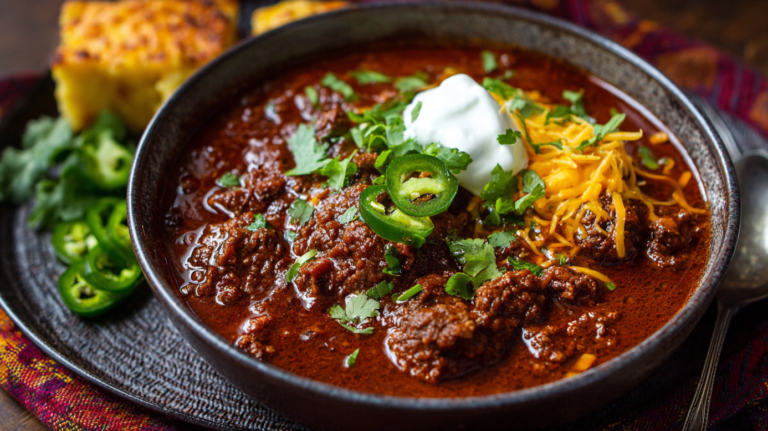When it comes to Texas-style chili, there’s one rule that’s more sacred than any other: absolutely no beans allowed. This isn’t just a preference—it’s a matter of state pride and culinary tradition that dates back over 150 years.
If you’re ready to master the art of making an authentic Texas chili recipe that would make any cowboy proud, you’ve come to the right place.
In this comprehensive guide, you’ll discover the secrets behind creating the perfect bowl of traditional Texas chili, from selecting the right cuts of beef to building complex layers of flavor with dried chilies and spices.
The Rich History Behind Texas Chili Con Carne
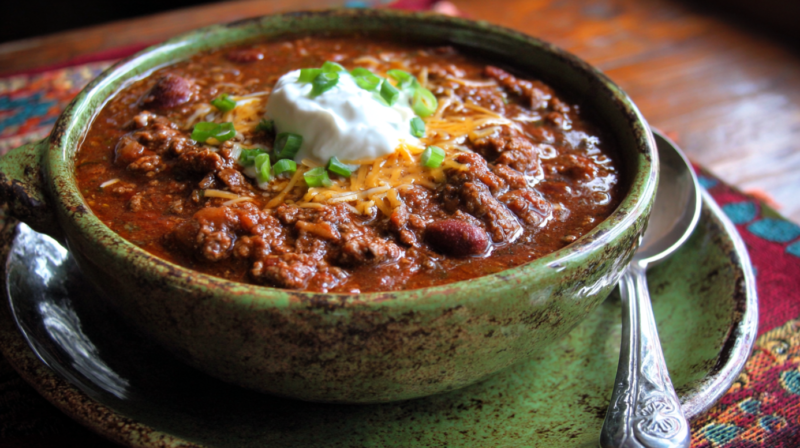
Understanding the heritage of Texas chili con carne helps explain why this dish holds such a special place in American cuisine. The story begins in the 1880s with the famous “chili queens” of San Antonio, who sold their aromatic beef and chile pepper concoctions from makeshift stands in the city’s plazas.
These pioneering women created a chili made from meat, chile peppers, and sauce, serving beans as an optional side dish but never mixing them into the chili itself.
The tradition became so deeply rooted in Texas culture that the Sixty-fifth Legislature officially declared chili as the state dish in 1977, boldly proclaiming that “Texans continue today the tradition begun in San Antonio 140 years ago of making the best and only authentic concoction of this piquant delicacy”.
This legislative seal of approval solidified the no-bean rule as a defining characteristic of authentic Texas chili.
Today, the spirit of competition and excellence continues at events like the Original Terlingua International Championship Chili Cook Off, which has been running since 1967 and is considered the “Grand Daddy of all chili cook-offs”.
These competitions maintain strict standards for what constitutes authentic Texas chili, ensuring the tradition lives on.
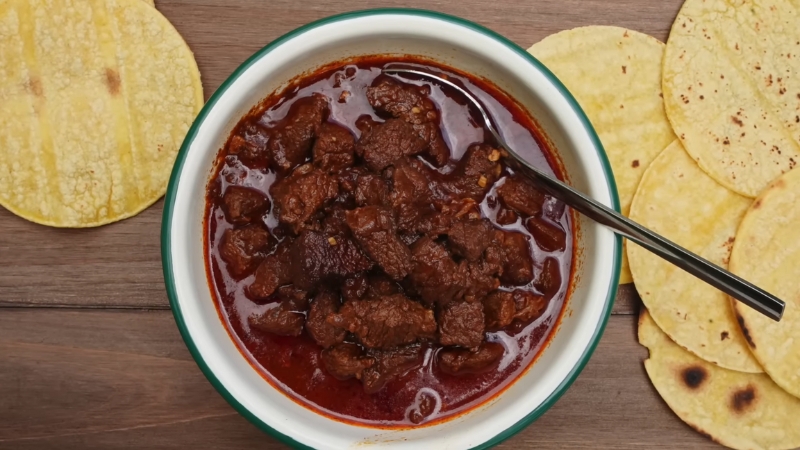
Authentic Texas Chili (No Beans)
Ingredients
Equipment
Method
- Prepare the ChiliesToast the ancho and guajillo chilies in a dry skillet over medium heat until fragrant (1–2 minutes). Soak in hot water for 15 minutes, then blend with ½ cup soaking liquid into a smooth paste. Set aside.
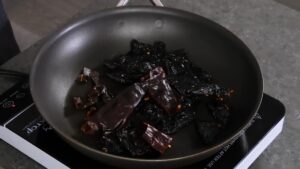
- Brown the BeefHeat oil in a Dutch oven over medium-high.Sear the beef in batches until browned on all sides. Remove and set aside.
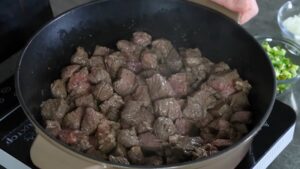
- Sauté AromaticsIn the same pot, sauté chopped onion until soft (5–7 minutes), then stir in minced garlic and cook for 1 more minute.
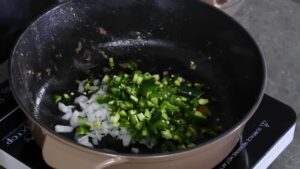
- Build the FlavorReturn beef to the pot. Add the chili paste, chili powder, cumin, smoked paprika, oregano, cinnamon (optional), salt, and pepper. Stir to coat. Add beef broth and vinegar. Bring to a simmer, cover, and cook on low for 2 to 2½ hours, stirring occasionally.
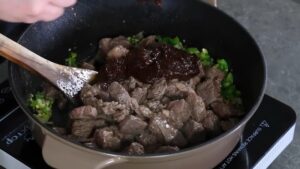
- Finish and ServeIf desired, stir in masa harina mixed with a bit of water to thicken during the last 15 minutes. Let the chili rest for 15–20 minutes before serving. Garnish as desired — just no beans!
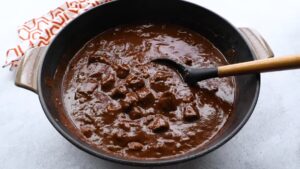
Video
Notes
Cooking Tips
- Flavor Boost: Add a splash of brewed coffee or a chopped chipotle in adobo for smokiness.
- Consistency: Use masa harina or blend and return some chili to naturally thicken.
- Storage: Improves with age — refrigerate for 5 days or freeze for 6 months.
- Heat Control: Taste as you go; spice levels vary by chili variety and batch.
Serving and Storage Secrets for Maximum Flavor
View this post on Instagram
Proper serving and storage techniques can make the difference between average chili and memorable chili that keeps people coming back for more. Understanding these details helps you present your hearty meat chili recipe at its absolute best.
Ideal Serving Temperature and Accompaniments
Texas chili should be served hot but not scalding, ideally around 140-150°F. This temperature allows the full range of flavors to come through without burning the palate. Serve in warmed bowls to maintain temperature throughout the meal.
Traditional accompaniments include cornbread, crackers, and chopped onions. Some Texans also enjoy their chili with a dollop of sour cream or shredded cheese, though purists might frown upon these additions. The key is letting the chili be the star while providing complementary flavors and textures.
Storage and Reheating Methods
Properly stored Texas chili improves with age, making it perfect for meal prep or advanced preparation for gatherings. Allow the chili to cool completely before refrigerating, where it will keep for up to 5 days.
For more extended storage, freeze portions in airtight containers for up to 6 months.
When reheating, add a small amount of beef broth or water to restore the original consistency, as the chili will thicken during storage. Heat gently over medium-low heat, stirring frequently to prevent scorching.
Avoid using high heat, as it can break down the meat’s texture and create an unpleasant, grainy consistency.
Common Mistakes to Avoid When Making Texas Chili
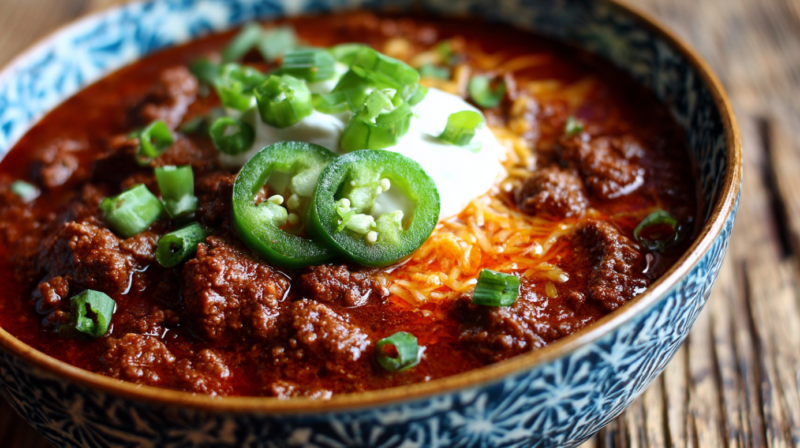
Ingredient and Technique Pitfalls
One of the biggest mistakes is using pre-ground chili powder instead of making your chili paste from whole dried chilies. Commercial chili powder often contains fillers and additives that can muddy the clean, bright flavors that define authentic Texas chili.
Taking the time to work with whole chilies yields a more complex and nuanced flavor profile.
Another standard error is not browning the meat properly. Overcrowding the pan or using insufficient heat prevents proper caramelization, resulting in gray, steamed beef instead of the rich, brown pieces that contribute significantly to the flavor of the final dish.
Brown the meat in small batches, allowing each piece to develop a proper crust.
Timing and Temperature Issues
Rushing the cooking process produces inferior results. Texas chili needs time for the connective tissues in the meat to break down and for the flavors to meld properly.
Trying to hurry the process with high heat often results in tough meat and harsh, unbalanced flavors.
Conversely, cooking at too low a temperature can prevent proper flavor development. The chili should maintain a gentle simmer throughout the cooking process, with small bubbles occasionally breaking the surface.
If the chili isn’t simmering, increase the heat slightly until you achieve the proper cooking temperature.
Conclusion
@marriedtobbq REAL Texas chili doesn’t NEED beans 😤 (but if you wanna add them, just toss ‘em in with the broth 😉) #bbqtiktok #texasbbq #chili #texaschili #awardwinning ♬ original sound – Breanna Stark
Whether you’re making no-bean chili for your family’s Sunday dinner or preparing a chili cook-off winning recipe for competition, the techniques and principles outlined in this guide will serve you well.
Start with quality ingredients, respect the process, and most importantly, enjoy the journey of creating something truly special.
The next time someone asks about authentic Texas chili, you’ll have the knowledge and confidence to create a bowl that honors the rich tradition while satisfying even the most discerning palates.
After all, knowing the difference between chili with beans and true Texas chili is one of those things only native Texans truly understand.
Great chili isn’t just about feeding people—it’s about creating memories and carrying forward a proud culinary heritage that defines Texas cooking at its finest.

